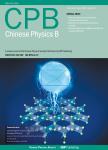Diffusion and collective motion of rotlets in 2D space
Diffusion and collective motion of rotlets in 2D space作者机构:Graduate School of Engineering ScienceOsaka University5608531 OsakaJapan
出 版 物:《Chinese Physics B》 (中国物理B(英文版))
年 卷 期:2020年第29卷第6期
页 面:37-43页
核心收录:
学科分类:07[理学] 070205[理学-凝聚态物理] 0805[工学-材料科学与工程(可授工学、理学学位)] 0704[理学-天文学] 0702[理学-物理学]
基 金:JST ACT-T Grant No.JPMJAX190S Japan and Multidisciplinary Research Laboratory System for Future Developments(MIRAI LAB).
主 题:rotlet diffusion Stokes flow
摘 要:We investigate the collective motion of rotlets that are placed in a single plane. Due to the hydrodynamic interactions,the particles move through the two-dimensional(2D) plane and we analyze these diffusive motions. By analyzing the scaling of the values, we predict that the diffusion coefficient scales with φ0.5, the average velocity with φ, and relaxation time of the velocity autocorrelation function with φ-1.5, where φ is the area fraction of the particles. In this paper, we find that the predicted scaling could be seen only when the initial particle position is homogeneous. The particle collective motions are different by starting the simulation from random initial positions, and the diffusion coefficient is the largest at a minimum volume fraction of our parameter range, φ = 0.05. The deviations based on two initial positions can be explained by the frequency of the collision events. The particles collide during their movements and the inter-particle distances gradually increase. When the area fraction is large, the particles will result in relatively homogeneous configurations regardless of the initial positions because of many collision events. When the area fraction is small(φ 0.25), on the other hand, two initial positions would fall into different local solutions because the rare collision events would not modify the inter-particle distances drastically. By starting from the homogeneous initial positions, the particles show the maximum diffusion coefficient at φ≈ 0.20. The diffusion coefficient starts to decrease from this area fraction because the particles start to collide and hinder each other from a critical fraction ~23%. We believe our current work contributes to a basic understanding of the collective motion of rotating units.



